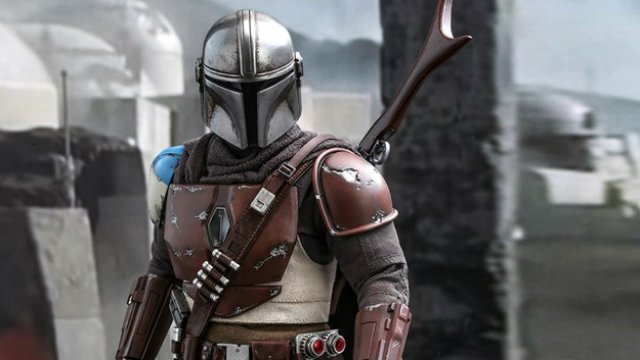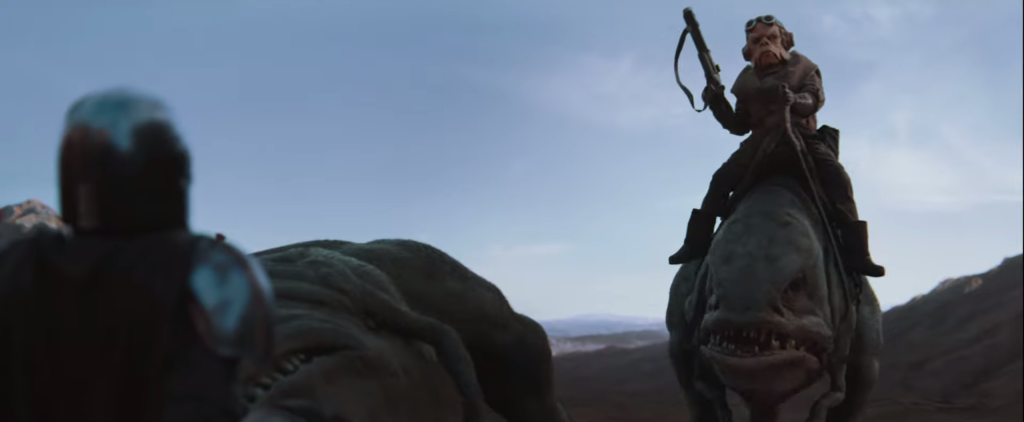Welcome to The Mandalorian Teleplay Chronicles. I will be reviewing every episode of The Mandalorian’s first season with an eye towards helping writers learn TV writing. Whether the show is a breakout hit or a Jar Jar Binks level bust, we’re going to be focusing on how to become better TV writers. It should be fun!
Genre: Sci-Fi (TV Drama – 1 hour)
Premise: A bounty hunter is tasked with locating and bringing in a rare bounty. But when he runs into a droid going after the same bounty, the two are forced to team up and bring it in together.
About: The Mandalorian is the first ever live action Star Wars TV show, which can be found exclusively on the new Disney Plus streaming service. Jon Favreau created the series and wrote the pilot episode. Long time George Lucas padawan Dave Filoni is making his live action directing debut with the Mandalorian pilot episode.
Writer: Jon Favreau
Details: 40 minutes long
The Pilot.
The most important episode of a TV show.
It’s either going to hook us and make us want more. Or bore us into a race to change the channel. Remote controls are like nuclear weapons in the hands of viewers. They only need to be bored for seconds to erase your show from their screen, and by association, existence.
For that reason, the first lesson in writing a pilot isn’t any different from the first lesson of writing a feature: WRITE A GREAT FIRST SCENE. Hook the viewer. Because if you have a great first scene, a viewer will give you some leeway. Most will give you a good ten minutes. And that’s enough time to convince someone your pilot is worth watching to the end.
Before I tell you how Mandalorian did in this department, let’s give you the lowdown on the plot.
The Mandalorian walks into a bar. No seriously. Mandalorian enters a bar on the outskirts of an icy world. He sits down to have a drink when some heavies – who are bullying a little amphibious man – start taunting him. Mandalorian hops up and beats up the guys he has to beat up and kills the guys he has to kill.
Amphibious Guy thanks him. Not so fast, Mandalorian says. He shows him a “puck.” Amphibious Guy is Mandalorian’s bounty. He’ll be coming home with him. The two grab an Uber from a flute-playing snout-alien and head to Mandlorian’s ship, which is resting on a thin sheen of ice. Just as they take off, an under-sea Hippopotamus creature breaks out of the ice and grabs the ship. Mandalorian electrocutes him with his electro-rifle and off they go.
Mandalorian places poor Amphibious Guy into carbon freezing and into storage with his other frozen bounties. He then meets up with his bounty-giver, Greef Carga. Greef confesses he doesn’t have any high-level bounties left, but he knows someone who does. So Mandalorian goes to this new guy who’s protected by Storm Troopers, which is weird because the Empire’s been destroyed (this takes place after Return of the Jedi).
Storm Trooper Owner gives Mandalorian a special bounty – so special he doesn’t even know where the exact location of the target is, only where it was last seen… 50 years ago! Mandalorian then engages in a really weird shoulder-armor making ritual with Female Mandalorian before shooting off to the remote rocky planet where his special bounty is hiding.
After hanging out with a guy I’ll call Billy Crystal in The Princess Bride because that’s clearly who this character was based on, Mandalorian engages in a cheesy scene where he must tame a lizard horse in order to ride it. He then waddles off to a remote town where he’s angry to find another bounty hunter there, a tall robot named IG-11. There are so many people guarding the target that Mandalorian must team up with IG-11 with a promise to split the bounty.
[SUPER MAJOR SPOILER IN NEXT PARAGRAPH]
In one of the best scenes in the pilot, IG-11 keeps threatening to self-destruct because he’s not allowed to be taken alive, and Mandalorian must talk him down WHILE also shooting back at the endless wave of bad guys. After a fun sequence where the Mandalorian takes out a giant hover-canon, the two break into the building where they find a tiny little hover-stroller. They lift the blanket and inside is a… a baby Yoda creature. Cut to black.
Okay, we’re going to get to all the screenwriting stuff in a second. But first let’s address this ultra-nerdy Star Wars ending.
I’m calling cheap shot. As we’re going to discuss, this episode wasn’t very good. And you don’t get saved just because you drop a WTF super star wars cliffhanger in at the end. It would’ve been much better had you crafted an ACTUAL clever ending, a payoff from an earlier setup, a twist built off character development, anything that had to do with writing as opposed to Star Wars mythology. Because you can’t keep doing that. You can’t have Baby Jabba the Hutt at the end of the second episode, Baby Han Solo at the end the third episode. This bought you some time. But it doesn’t cover up the average writing throughout the rest of the episode.
Let’s get back on track here. Time to learn about TV writing.
Like I said, the first order of business is writing a great first scene to your pilot. Favreau tries to do that here. Showing your character kick the butts of a bunch of bullies is a solid way to pull us in. There was also a nice little twist at the end where Amphibious Guy thinks he’s been saved, when, in actuality, he’s just been caught.
The second most important thing you’re trying to do in a pilot is get the audience to care about your hero. Doesn’t necessarily mean they must like him. But they have to care about him. Mandalorian beating up baddies makes us care about him (or at least enough to keep us intrigued).
But here’s the first thing I didn’t think about going into the series that now I’m very worried about. The main character doesn’t take off his mask. It’s hard for audiences to connect with people whose eyes they can actually see. To build a show around a character whose face we never see? How are you going to build a connection? Has this ever been tried before? I don’t think so. And I definitely didn’t feel closeness to the Mandalorian. I’m interested in him cause he looks cool. But if I’m not going to get any face to face connection with him at all, I predict that being a major problem moving forward.
Once you’ve written a great opening scene and you’ve made us care about your protagonist, your job is to move into the episode goal as soon as possible. You can delay this if interesting things are happening. And that’s what Mandalorian does. Before he can return his bounty and receive his goal, Mandalorian is attacked by an ice monster. Stuff like that is fine because there’s conflict and stakes and danger. We’ll stick with you if your protagonist is battling obstacles before he gets to his goal.
Mandalorian finally returns his bounty and gets his episode goal. And there’s a bigger TV lesson to learn here. You want to come up with show ideas that naturally lend themselves to repeated goals. This is why cop and hospital and law shows are so popular. There’s always another criminal to take down. There’s always another patient to save. There’s always another court case to win. This means that every episode has natural goals built in.
The Mandalorian swims in these same waters. Bounty-hunting is a goal-oriented business. You always have another bounty to go after. This should make episode-writing easy. Because when you don’t have this stuff built in, you have to come up with goals out of thin air every episode and that can be difficult.
Throughout your middle acts, your focus should be on introducing the other characters in interesting ways. Remember, features are about plot. TV is about character. You can get away with thin secondary characters in a feature. Not the case in a TV show. Most of the characters you create are going to have an hour or more of screen time a season. So you can’t just come up with a cool character. You have to think about what their past is like (if they’re battling demons, trying to escape something), what kind of problems they’re dealing with in the present, and what kind of interesting places the story might take them in the future.
For whatever reason, this episode of Mandalorian was only 40 minutes long. And outside of Billy Crystal and IG-11, we didn’t get to know anyone that well. So I’d say Favreau failed in this department. I barely know any of the characters after Mandalorian Chapter 1.
After all your hard work, you are rewarded with the best thing about writing for TV: You don’t have to wrap everything up! Wrapping things up is the hardest part about writing a feature. Maybe 5% of movies have great endings. With TV, all you need to do is give us an ending that makes us want to come back for more. You don’t have to have any idea where that ending goes. You just have to give us something exciting. Here, it’s Baby Yoda. For you, it will be something more creative. Something story-based.
I was hoping this show would provide me with a lot of examples of how to write a pilot. Unfortunately, this proves that even if you’re following the blueprint, you can still fail. The choices you make can be average, even if they’re “right.” For example, the opening scene where Mandalorian beats up and kills a bunch of guys in a bar is a decent scene. But nothing I haven’t seen before. As a writer, you should always be looking to elevate your choices beyond the choices of everyone else. Not just give us slight variations on stuff we’ve already seen.
The biggest thing I’m bummed about here is how lonely this episode felt. I’ve never experienced that before watching a Star Wars movie. I don’t know if they were going for that on purpose or not but it was unpleasant. The only time this felt like good Star Wars was when Mandalorian and IG-11 teamed up. Outside of that, this was a bummer beginning to this series.
[ ] a total bust
[x] this show is in trouble
[ ] at least it’s Star Wars
[ ] pretty darn good
[ ] off to an amazing start
What I learned: Always look for a spin on classic lines. In that first scene, where Mandalorian corners Amphibious Guy, Amphibious Guy resists him. Mandalorian says, “I can take you in…”. What’s the line that everybody says after this? I can take you in… [what]. “Dead or alive” right? But that line’s been used to death. So look for a spin on it. Mandalorian says, “I can bring you in warm or cold.”



